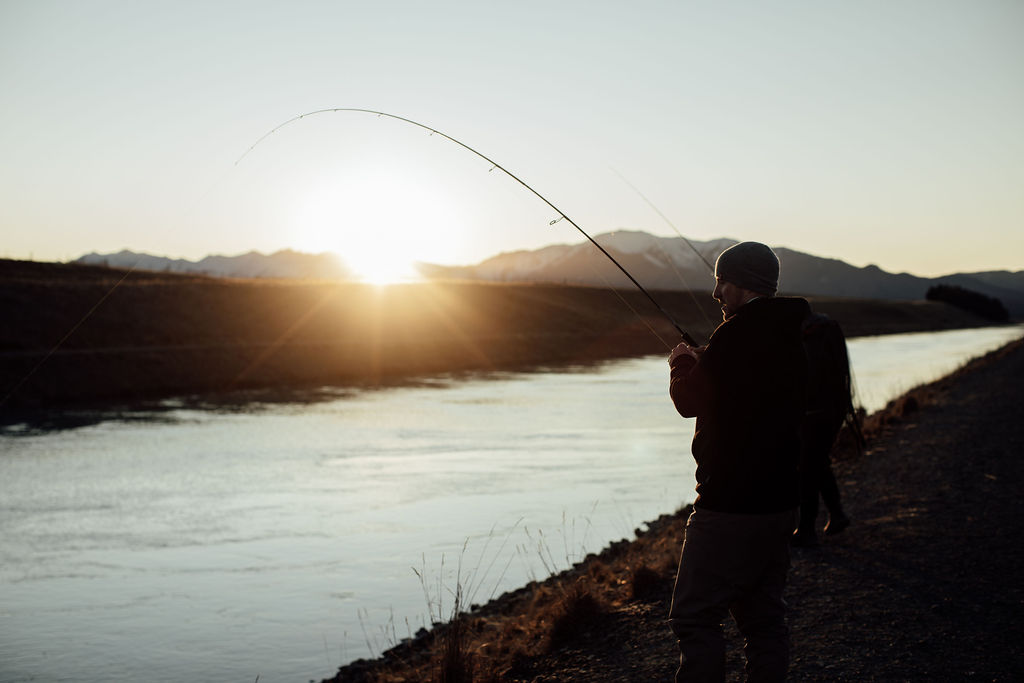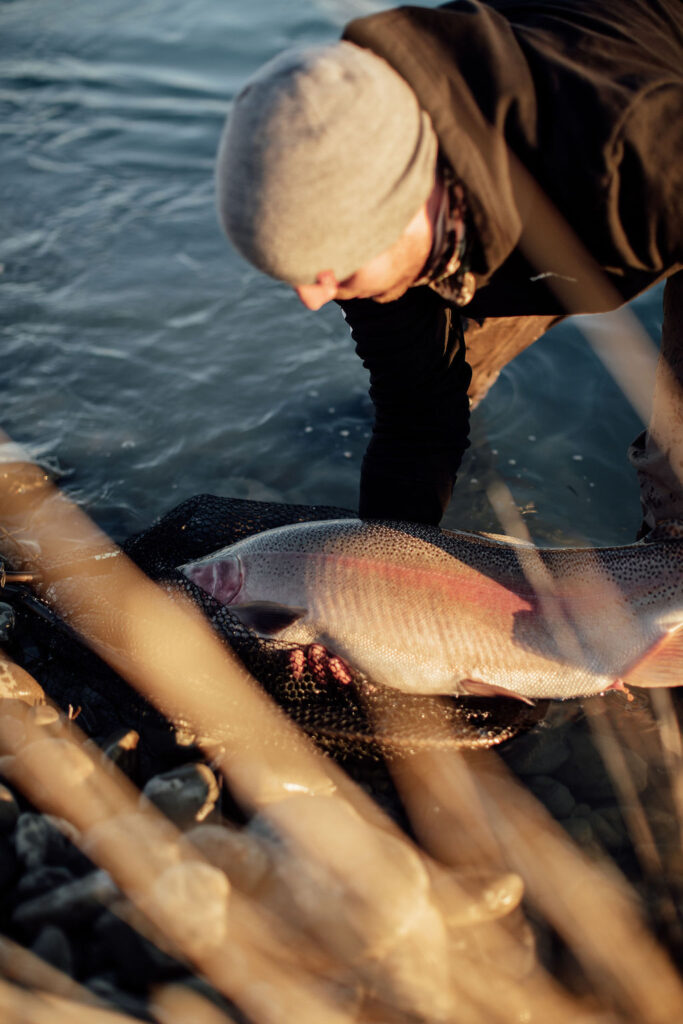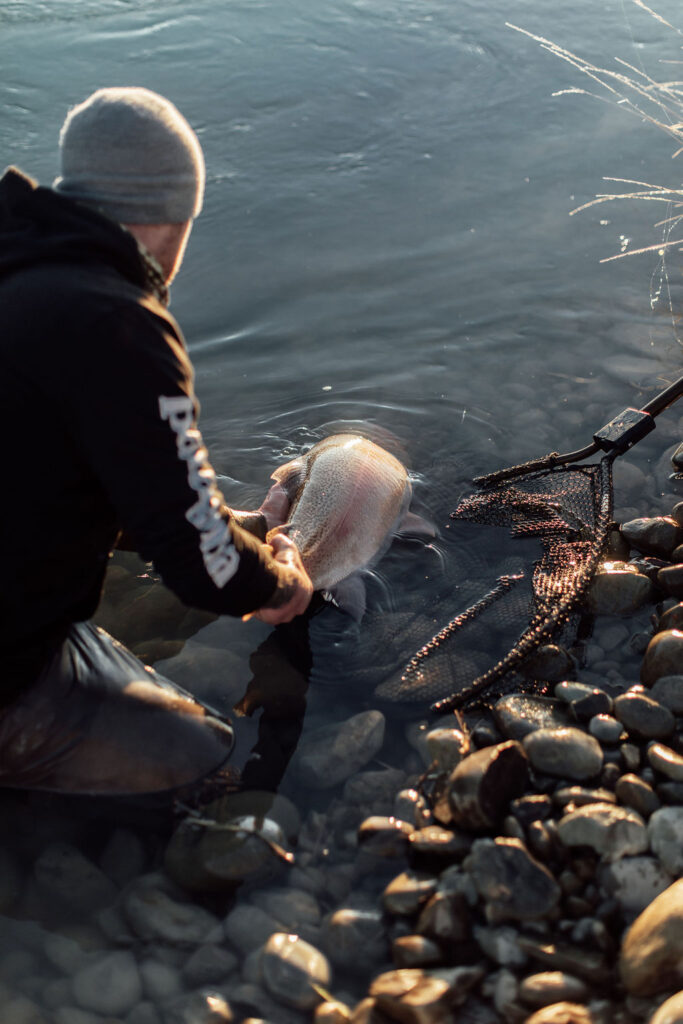As a hunter I often find myself looking to the mountains when driving through the Mackenzie Basin, and if I’m lucky, it’s because I’m on my way to a very anticipated hunt. But there’s been times where, due to weather, we’ve been pulled out of a hunt early or been delayed. With these rather unfortunate turns of events, it can leave you in the Mackenzie basin with bugger all to do apart from keep the local pokies full and bar kegs empty.
For anyone who has driven through the inland route of the south island, you would have seen the rich blue waters flowing through the Mackenzie basin. What you’ll see is that New Zealand has one of the world’s top trout fisheries: the Mackenzie country hydro canals.
Trout and salmon in these waters grow to some absolutely ridiculous sizes, some in excess of 40 pounds with many a world record now owed to these canals.
As a lot of you already know, there are salmon farms on the canals so the theory is that these fish get big purely because they gouge themselves on salmon food. This does seem like an easy answer but it’s not 100% correct. Yes some fish do manage to feed off pellets around the pens but with thousands of hungry salmon in the pens not a huge amount gets through the nets. The canals are obviously man made and controlled by dams which regulate flow. These stable flow rates and the constant cool glacial lake temperatures help bug life thrive and therefore give the trout a constant supply of nutrient rich foods and the perfect temperatures for the fish to pack on the pounds.
Here’s a few tips for catching these monsters:
There are a tonne of different ways to target these beasts but my favourite by far has to be ‘Egg Rolling’. This technique is able to be used all year round but is most commonly used between the months of June and August when the larger fish make their spawning run and their smaller hungry followers tag along for an easy feed of stray eggs.

The Set Up
The ideal set up is a relatively light weight rod of between 7’6″–9′ long which has a cast weight of around 3–21g or close. The reel should be in the size range of 1000–3000 with a braided line of 4–10lbs. There are a huge number of rods and reels available in this range but for me there is only one choice: the Shimano Dialuna 8’6″, 3–21g rod and Shimano Stella 2500 reel loaded with a Sufix 832 6lb braid.
The rig itself is actually pretty simple. It consists of your fluorocarbon (high density mono filament) leader – around 6–8lb – tied to one end of your braided line and the other to a three way swivel. Off the bottom ring on the swivel tie around 200mm of 5lb nylon to a drop shot sinker (1/8th–1/2oz) and on the opposite end of the swivel tie on about 1 metre of fluoro that’s been tied to an egg imitation (in today’s case we ran with two eggs). To do this you tie another piece of fluoro to the bend in the hook on the first egg and trail the second about 200mm behind the first. Legally you can fish up to three. The market for these imitation fish eggs over the last few years has become huge and the colours and sizes are almost endless – everyone seems to have their favourites. Like any good projectile though, the best are the ones that hit their targets.
Time to cast
I like to cast upstream on a 30–45 degree angle – depending on the speed of the flow – and keep an eye on my braid on the water as my gear sinks. Usually around the time it’s straight out from you (90 degrees) you should feel a slight tapping on the bottom as the sinker bounces along the bottom of the canal carried by the resistance of the line in the flow of the water. With my rod pointed down my line, I spin the reel handle a few times to take up any slack line and start to walk down stream trying to maintain the best contact with my gear as I can. I find resting my finger on the braid is crucial to detect the bite. You may decide to just fish a small section of 50 or so metres, or in some cases a few hundred metres before you walk back to the top to repeat your drift.
The bite itself can be tough to detect some times as factors such as wind or the canal flow can throw slackline into the system either delaying the feel or, in some cases, completely removing the difference between the bouncing of the sinker and the tug of a fish.
Bite detection is the most critical part of this style of fishing. In a lot of cases, if a fish takes the egg and you don’t set the hook the trout will spit the fly before you’ve even realised it’s been eaten. For this reason I always urge people new to this type of fishing to really take note of their line management and concentrate on staying as tight with their gear as possible while keeping the sinker bouncing along the bottom to help best detect that bite as it might be the difference between drowning your sorrows that night at the pub or an epic ending to a trip to the Mackenzie Basin.
Once connected to one of these fish the hard part is done! Don’t stress! I’ve seen more fish lost by people panicking after the hook is set when really they had everything under control. Try to keep your rod on a 45 degree angle to the fish to keep the hook angled well in the fish’s mouth. The rod will be acting as a big shock absorber soaking up the fish’s energy and taking the shock out of the line so hopefully you don’t have any issues with knots failing. If the fish wants to run and take some line it’s a good thing, don’t panic! The more energy it uses the sooner it can come to the net. After all, it’s got nowhere to go … it’s in a canal so you can follow it.
Get it in the net
Once this huge fish in all its glory has come in close and you have laid eyes on it it’s easy to get too keen and dive on in with a rushed net job, don’t! Once again, take your time. I prefer to only get the net involved when the fish is actually ready and in close, because spooking it and having it take off busting your line when you try stabbing at it with the net frame when it’s not quite ready is an all too common occurrence.
Hold the net out near flat on the water, guide your fish in head first over the net frame lifting the net and dropping the tension off your line simultaneously. Now you have caught your first canal monster. Leaving the fish in the net in the water you can now wipe your brow and scream and yell to the boys, “oi take a pic bro!”.
Now this bit is important as it’s going to help you remember this fish forever: don’t smash it’s head in. Imagine how great your hunting photos would be if every deer had it’s head caved in yet most of us try to set our animals up nicely and have them look as happy and natural as possible.
We can do the same with our trout but with a difference. If you lift that fish up it’s going to start gasping for oxygen and quickly do everything it can to try to get back in the water and in a lot of cases, due to the mass of these fish, it’s going to succeed and leave you wet cold with a blurry picture of the one that got away.
The easiest option is to get down nice and low on the water’s edge and get your shots there where the fish is most happy and therefore most likely to give you the time to get the pictures to look back on in years to come. They generally don’t go crazy to get away as long as they’re still in the water and able to breathe, so it is possible to get some stunning images while they are all coloured up.


Release
The final step for me is the release. It’s not compulsory but I feel like we do have to break the cod fisherman’s mentality of killing everything as these big fish are our spawning stock and not only that, they are our next generation’s fish too, and with some fish estimated at over 10 years old they can pass on their trophy genetics every year to a new batch of fingerlings ready to grow big in the canal’s food rich currents. Break the mould and feel the rush of knowing you have some epic shots of a fish in it’s natural spawning colours rather than covered in grass, sticks and blood, and then send ‘em home.
I guarantee that this feeling will leave you pumped and wanting more as you watch your trophy swim home into the shadows.
Hopefully now a few of you will drive through the Mackenzie Basin with a new outlook. Allow for some extra time, take notice of the glacial blue water flowing through the canals and the world class fish it holds, but also make sure you have a rod and reel ready.









